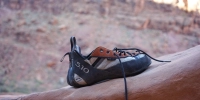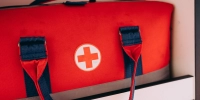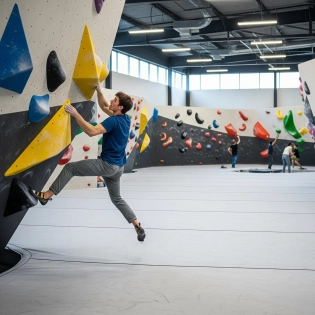







Climbers Point

While generally you can go climbing without climbing shoes, it is highly recommended to wear climbing shoes. Some indoor gyms also require the use of climbing shoes and forbid climbing in anything other than them.
You don't need to wear socks with rock climbing shoes, most people don't, but many people do for different reasons.
If you have blisters, wounds, or want to prevent blisters, a thin pair of socks can help quite a bit with that.
If your shoes are a little bit too loose, socks could help tighten them up.
Some people also just like climbing with socks.
Climbing shoes are generally designed to be very snug around your feet, with no socks in between them and your feet, but in the end it's up to you if to wear socks or not.
The amount of time it takes climbing shoes to break in and to stop being painful depends on a few things, such as the specific shoes, their size, the material of the shoes, and how often you climb in them.
The most important thing is to, first, get the right shoes for your feet, and the right size. If you get shoes that just don't fit your feet, it won't matter what size you get, they just won't be a good match for your feet.
The same goes with sizing. Even if you find the perfect shoes that match the shape of your feet perfectly, but you don't get the correct size, it won't matter that they fit like a glove.
Both things go together and both can determine how long the break-in period will last, and how long the shoes will hurt, if they even will.
Here is some more information on breaking in climbing shoes.
Even beginners can benefit from climbing shoes, this is especially true for outdoor rock climbing, where climbing shoes can be considered a necessity.
Some indoor climbing gyms also require all climbers to climb in climbing shoes, even beginners and first-timers, so climbing shoes would be a must in that situation.
To make a point about climbing shoes and getting used to them – it's better to start earlier than later. Climbing shoes are very different from your everyday shoes. They are tight and uncomfortable, at least in the beginning until you get used to them. That's why it's better to just get it out of the way and start wearing them. The sooner you get used to them, the better.
Most climbers prefer not to wear socks with climbing shoes, though, there is no rule against it.
Many climbers do in fact wear socks with climbing shoes for different reasons. Their shoes may be slightly too loose, and wearing socks could give them that extra layer that tightens things up.
Wearing socks could also help prevent blisters, or reduce pain if there are already blisters or other wounds on your feet as well.
So just because most climbers don't wear socks with climbing shoes, it doesn't mean there are no cases where it can be very helpful. Some people also just prefer sock in climbing shoes. It's up to you in the end.







